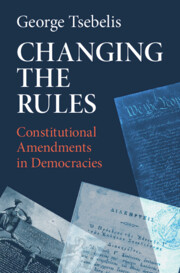Tables
I.1Two-person game (Player A with three and Player B with two strategies)
3.1Difference between actual and formal rigidity: As n increases, the error term (difference) approaches zero
3.2Effect of formal rigidity on another variable (constitutional amendments): As n increases, the coefficient approximates the true value
3.3Estimation of coefficient of “culture” as a lagged dependent variable: When institutional data are serially correlated, including a lagged dependent variable will inflate its estimated effect and lead to misestimation of other variables including the wrong sign
3.4Association of indicators of culture from Tarabar and Young (2021) with economic outcomes (based on IMF data) are not as expected
4.1Reasons for “NO” vote of Chilean referendum in September 2022
4.2Reasons for “NO” vote of Chilean referendum in December 2023
4.3What are all the reasons why you voted “NO” at the referendum on the European Constitution?
5.1Congressional seats of main parties in Mexico (1997–2015)
6.1Correlation of veto player constitutional rigidity index with other indexes
6.2Comparison of three models of effects of constitutional rigidity (null, mean only, and heteroskedastic) on amendment rate for POLITY2 ≥ 5 threshold 103 countries; likelihood ratio tests
6.A.1.1Results of the heteroskedastic regression for fundamental amendments (POLITY2 ≥ 5)
6.A.1.2Results of the heteroskedastic regression for the combination of fundamental and major amendments (POLITY2 ≥ 5)
6.A.1.3Results of the heteroskedastic regression on all amendments (POLITY2 ≥ 5)
6.A.2.1Comparison of three models of effects of constitutional rigidity (null, mean only, and heteroskedastic) on amendment rate for POLITY2 ≥ 6 threshold (ninety-five countries; likelihood ratio tests)
6.A.2.2Comparison of three models of effects of constitutional rigidity (null, mean only, and heteroskedastic) on amendment rate for POLITY2 ≥ 7 threshold (eighty-three countries; likelihood ratio tests)
6.A.2.3Comparison of three models of effects of constitutional rigidity (null, mean only, and heteroskedastic) on amendment rate for POLITY2 ≥ 8 threshold (seventy-two countries; likelihood ratio tests)
6.A.2.4Comparison of three models of effects of constitutional rigidity (null, mean only, and heteroskedastic) on amendment rate for POLITY2 ≥ 9 threshold (fifty-four countries; likelihood ratio tests)
6.A.2.5Comparison of three models of effects of constitutional rigidity (null, mean only, and heteroskedastic) on amendment rate for POLITY2 ≥ 10 threshold (thirty-five countries; likelihood ratio tests)
6.A.3.1OLS regressions of different amendment rates (POLITY2 ≥ 5 cutoff) on constitutional rigidity and social capital (n = 57)
6.A.3.2OLS regressions of different amendment rates (POLITY2 ≥ 5 cutoff) on constitutional rigidity and each indicator of social capital separately (n = 57)
7.2Constitutional length as a function of country characteristics
7.3GDP per capita as a function of constitutional length and economic variables
7.4GDP per capita as a function of length, economic variables, education, and corruption
8.5Effect of constitutional rigidity on percentage of strikes (sample: POLITY2 ≥ 5)
8.6Comparison of three models of effects of constitutional rigidity (base, mean only, and heteroskedastic) on judicial strikes for POLITY2 ≥ 5 threshold (likelihood ratio tests, n = 30)
8.A.1Data used in the analysis (constitutional and unconstitutional judgments) from the Comparative Law Database

